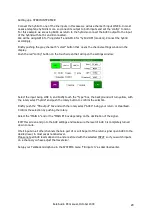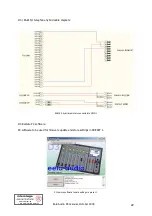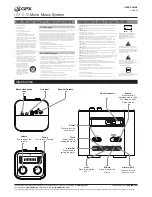
Eela Audio D3 manual, October 2009
17
STUDIO MONITOR FOLDBACK:
The AUX output configuration screen in the main menu.
The signal that is fed to the loudspeakers in the studio room. This signal can be adapted depending
on your way of working. In some radio studio’s (or TV) people don’t use headphones. With an AUX
you can make a mix of all post fade signals EXCEPT the studio microphones. The signal can be loud if
no microphones are in use and dimmed upon opening of one of the studio microphones. The amount
of dimming can be adjusted in the D3. Also this signal is replaced by a TalkBack signal upon pushing
the TB button.
As the D3 mixing desk can be used in a true “split” mode e.g. an automated program is playing on air
and at the same time making a recording you have to be able to select which signals must be present
in the CLEANFEED, FOLDBACK or RETURN. That is why an post fade AUX is used for this purpose and
you have to open up the AUX volume controls of ALL channels that must be present in this mix en
close the others.
D3 System settings Studio and CR LS dim.
TALKBACK:
Talkback is only possible when a microphone is set to be the TalkBack microphone in the SYSTEMS
menu ‘TB input ch:’ (and this channel is set to MIC input and a microphone is present)
The TALKBACK button is only visible if a channel PFL button is active of a channel that has the ‘TB
aux’ set to a certain AUX output. Touching this green Talkback button it will turn red and the signal of
this AUX is replaced by that of the TalkBack microphone. Active as long as it is pressed.
If ‘mixed pfl’ is set and more than one channel with TB to Aux are in PFL mode than the TalkBack
signal is send to these Aux outputs simultaneously.






































